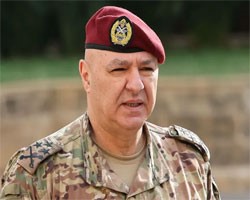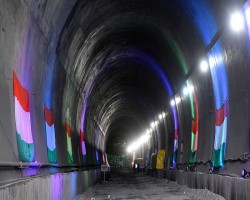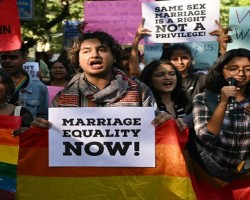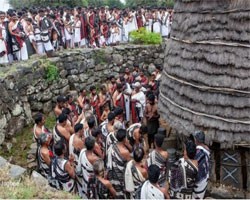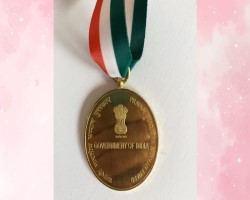Banking Current Affairs
TABLE OF CONTENTS |
| International Relations |
|---|
|
|
|
Why in the news?
Lebanon's Parliament has elected General Joseph Aoun, the country's army chief, as president, ending a two-year political impasse. Key Points: Election Outcome: General Aoun secured 99 out of 128 parliamentary votes, surpassing the required majority of 86. Background: A 60-year-old career soldier, Aoun has led the Lebanese army since 2017, focusing on maintaining the military's neutrality amid Lebanon's complex political landscape. International Relations: Aoun is viewed as the preferred choice of both the United States and Saudi Arabia, indicating potential shifts in Lebanon's foreign policy and internal governance. Hezbollah's Influence: His election may lead to a reevaluation of Hezbollah's role within Lebanon, as Aoun has emphasized the state's monopoly over weapons, hinting at the disarmament of the group. Economic Crisis: Lebanon is currently facing a severe economic crisis, with the local currency losing over 90% of its value and a significant portion of the population living in poverty. |
|
|
|
About Lebanon:
Capital: Beirut President: General Joseph Aoun (elected in 2025) Prime Minister: Najib Mikati (as of 2025) Currency: Lebanese Pound (LBP) |
| National |
|
|
|
Why in the News?
Prime Minister Narendra Modi is set to inaugurate the Z-Morh Tunnel on January 13, 2025. The tunnel is a critical part of the year-round strategic Kashmir-Ladakh corridor, ensuring uninterrupted connectivity between the two regions. Key Takeaways: Project Details: The Z-Morh Tunnel is a 6.5 km, 2-lane road tunnel situated on the Srinagar-Leh Highway between Gagangir and Sonamarg in Jammu and Kashmir. It is located at an elevation of 8,960 feet and is named after the Z-shaped road stretch it replaces. The tunnel supports a maximum speed of 80 km/h, with a capacity of 1,000 vehicles per hour. Importance for Tourism and Connectivity: Ensures Sonamarg remains accessible year-round, overcoming disruptions caused by heavy snowfall and avalanches in winter. Boosts tourism by making Sonamarg a prominent winter destination in Kashmir. Supports locals in maintaining supplies and avoids seasonal migrations to Srinagar. Strategic Significance: Provides all-weather connectivity between Srinagar in Jammu and Kashmir and Kargil in Ladakh. Complements the 14.15 km Zojila Tunnel to the east, enhancing India’s military logistics and capabilities in the region, particularly along the Line of Control (LOC) and Line of Actual Control (LAC). Economic Impact: Expected to increase footfall in the region, boosting local businesses and creating new opportunities for hoteliers and other service providers. Prime Minister’s Visit: This is PM Modi’s first visit to Kashmir since the formation of an elected government in the Union Territory. Comprehensive security measures have been implemented in Srinagar and the Valley ahead of the event. About the Z-Morh Tunnel: Location: Between Gagangir and Sonamarg on the Srinagar-Leh Highway. Length: 6.5 km. Elevation: 8,960 feet. Capacity: 1,000 vehicles per hour at a maximum speed of 80 km/h. Purpose: To replace the Z-shaped stretch of road prone to closures during winters. 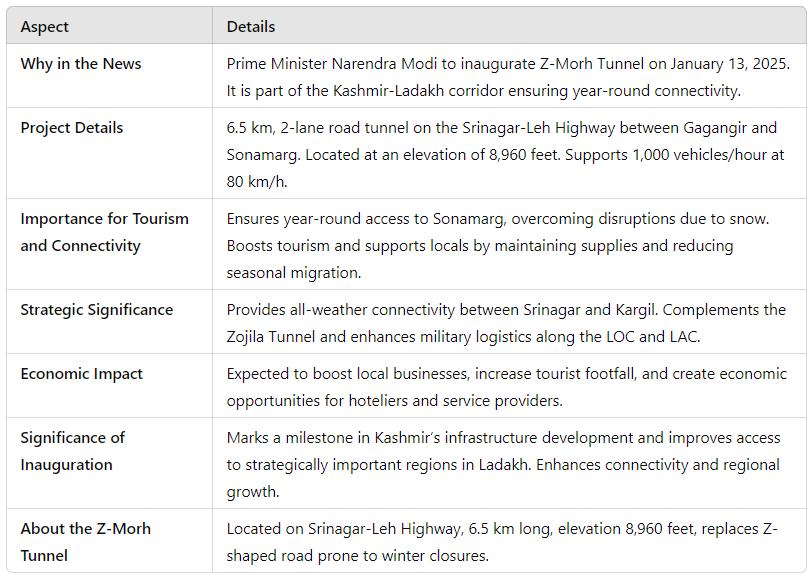
|
|
|
|
Why in the News?
The Supreme Court of India has dismissed petitions seeking a review of its October 17, 2023 ruling, which had rejected the plea for legal recognition of same-sex marriages. Key Takeaways 1. Supreme Court’s Ruling Five-Judge Bench Decision: The bench comprising Justices B R Gavai, Surya Kant, B V Nagarathna, P S Narasimha, and Dipankar Datta found no apparent error in the 2023 ruling that denied legal recognition to same-sex marriages. Institutional Limitations: The Court cited its institutional limitations, stating it cannot amend or strike down provisions of the Special Marriage Act (SMA), 1954. Parliament’s Role: The decision leaves it to Parliament to legislate on the issue. 2. Special Marriage Act (SMA), 1954 The SMA provides a legal framework for civil marriages across religions, but it currently does not recognize same-sex unions. The Court ruled there is “no unqualified right to marriage” and a same-sex couple cannot claim it as a fundamental right under the Constitution. 3. Civil Unions Debate Minority View: Former Chief Justice D Y Chandrachud and Justice (retired) Sanjay Kishan Kaul advocated for recognizing civil unions for same-sex couples. A civil union offers legal rights similar to marriage but does not equate to marriage under personal law. They argued that the right to civil union could be traced to Part III of the Constitution, placing a positive obligation on the State to recognize it. 4. Ethical and Legal Questions Complexity of Legalization: Legalizing same-sex marriage involves balancing constitutional rights with social and cultural traditions. Marriage as an Institution: Marriage in India is deeply intertwined with religious and societal norms, which makes redefining it contentious. 5. Broader Context Global Trends: Several countries have recognized same-sex marriages, reflecting a global shift toward inclusivity and equal rights. India’s Learning Curve: India can draw lessons from other nations on balancing tradition with constitutional rights. Ethical Dimensions: The denial of legal recognition raises questions about equality, dignity, and human rights of LGBTQIA+ individuals. Do You Know? In the 2023 ruling, the Constitution Bench (3-2 majority) unanimously declined to recognize same-sex marriages and civil unions. Justices Chandrachud and Kaul supported civil unions as a step toward ensuring basic rights for same-sex couples. Conclusion The Supreme Court's decision underscores the institutional limitations of the judiciary in redefining marriage laws, while shifting the responsibility to Parliament. This ruling has reignited discussions on LGBTQIA+ rights, the need for inclusivity, and the balance between constitutional principles and societal values in India. |
| Science and Technology |
|
|
|
Why in the News?
India and the United States have entered into a strategic partnership to co-produce sonobuoys for enhancing Undersea Domain Awareness (UDA), strengthening India’s naval capabilities. This collaboration, announced during U.S. National Security Advisor Jake Sullivan’s visit to India, highlights mutual concerns about Chinese naval activity in the Indian Ocean Region. Key Takeaways 1. What are Sonobuoys? Definition: Devices used to detect submarines in deep waters. Purpose: Deployed from aircraft or ships to monitor underwater sounds, essential for anti-submarine warfare. 2. Importance of Undersea Domain Awareness (UDA) Definition: UDA involves monitoring and understanding activities in underwater environments. Significance: Vital for national security, especially in regions with hostile naval forces. Ensures maritime safety and stability in the Indian Ocean Region. 3. Role of Ultra Maritime and Bharat Dynamics Limited (BDL) Collaboration: Ultra Maritime, a leader in undersea warfare technology, partners with BDL. Focus: Developing sonobuoys tailored to Indian Ocean conditions. Alignment: This partnership supports the U.S.-India Initiative on Critical and Emerging Technologies (ICET) launched in May 2022. 4. Production and Interoperability Goals Manufacturing: Sonobuoys to be made per U.S. Navy standards. Production shared between India and the U.S., supporting India’s ‘Make in India’ initiative. Interoperability: Ensures seamless use across platforms operated by both nations and their allies. 5. Recent Developments in Maritime Cooperation India’s Acquisitions from the U.S.: P-8I maritime patrol aircraft. MH-60R helicopters. $3.5 billion deal for MQ-9B drones. Strategic Alliances: Partnerships like the Quad (India, U.S., Australia, Japan) enhance regional security and collaboration. 6. Broader Implications for Regional Security Focus on UDA: Crucial for maintaining security in the Indian Ocean Region. Supports effective naval operations and counters emerging threats. Significance of Partnership: Strengthens maritime stability. Demonstrates a commitment to addressing Chinese naval influence. Future Directions in Defence Collaboration Enhanced India-U.S. cooperation expected to drive technological advancements in defence. Likely to foster more joint initiatives focusing on maritime security and defence innovation. |
| Culture |
|
|
|
Why in the News?
The Toda tribe, an ancient Dravidian ethnic group residing in the Nilgiris Hills of Tamil Nadu, celebrated their Modhweth Festival in December 2025. The festival, held at Muthanad Mund, marks the New Year and highlights the tribe’s cultural identity, emphasizing health, agriculture, and unity. Key Takeaways 1. Significance of Modhweth Festival Importance: Modhweth is the most significant festival for the Toda tribe. It occurs annually on the last Sunday of December or the first Sunday of January. Purpose: Community members seek blessings for health, prosperity, and livestock well-being. Prayers are offered to their deity Shakti. Spiritual Belief: The Toda tribe believes their wishes are fulfilled through their prayers. 2. Rituals and Celebrations Commencement: Prayers were held at the Moonpo Temple, dedicated to their deity Tenkish Amman. Prayers focused on health, rainfall, and abundant harvests. Unity Symbolism: A shared buttermilk ritual symbolized communal unity. Traditional songs and dances showcased the tribe's cultural heritage. Stone-Lifting Ceremony: Young men lifted an 80 kg greased boulder, demonstrating strength and balance. 3. The Moonpo Temple The Moonpo Temple is a historic site for the Toda tribe. Features a distinctive vertical thatched roof with a flat stone atop. One of the last remaining examples of its kind in the Nilgiris. Attracts both the Toda community and tourists interested in cultural heritage. 4. The Toda Community Population: Around 50 members, classified as a Particularly Vulnerable Tribal Group (PVTG). Occupation: Primarily cattle-herding and dairy work. Settlements (Mund): Small, thatched houses shaped like half-barrels. Religious Practices: Revolve around a pantheon of gods, with Tökisy and Ön being central deities. Diet: Strictly vegetarian, avoiding meat, fish, and eggs. The Modhweth Festival highlights the Toda tribe's rich cultural and spiritual heritage, showcasing their dedication to community values, unity, and traditions. It also brings attention to the preservation of their unique identity in the Nilgiris. |
| Awards |
|
|
|
Why in the News?
The Pravasi Bharatiya Samman Awards (PBSA), the highest honor for overseas Indians, will be conferred by President Droupadi Murmu on January 12, 2025, during the Pravasi Bharatiya Divas (PBD) Convention held in Bhubaneswar, Odisha. This year, 27 individuals and organizations from 24 countries will be recognized for their contributions in various fields. Key Takeaways: Highlights of the Awards: The PBSA recognizes the achievements and contributions of Non-Resident Indians (NRIs), Persons of Indian Origin (PIOs), and organizations run by them. Awardees represent the diversity and impact of the 35.4 million-strong Indian diaspora globally. Countries represented include Malawi, Fiji, Spain, Romania, the US, the UK, and others. Objective of PBSA: To honor the excellence achieved by the Indian diaspora in fields such as science, technology, medicine, community service, business, and more. The awards showcase the diaspora's role in fostering global ties and their contributions to India’s development. Notable Awardees: Lehk Raj Juneja (Japan): Category: Science & Technology. Contributions: Formerly associated with a pharmaceutical firm, now leads a snack company, blending Indian and Japanese work ethics. Syed Anwar Khursheed (Saudi Arabia): Category: Medical Science. Contributions: Served as a royal protocol physician for the Saudi royal family; previously worked at King Faisal and National Guard Hospitals. Robert Masih Nahar (Spain): Category: Community Service. Contributions: Politician and Senate member from Catalonia; promotes local cricket and is known as the "godfather of cricket" in Catalonia. About the PBD Convention: The 18th edition of the Pravasi Bharatiya Divas Convention will be held from January 8–10, 2025, in Bhubaneswar. The PBSA will be conferred during the Valedictory Session of the convention. A Jury-cum-Awards Committee, chaired by the Hon’ble Vice-President and co-chaired by the Hon’ble External Affairs Minister, selected the awardees unanimously. Complete List of Awardees:  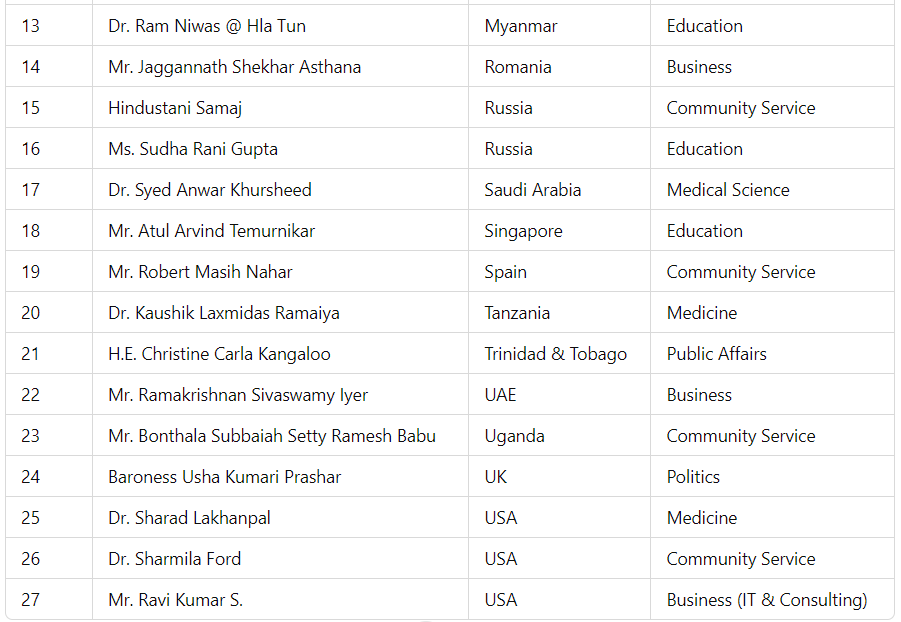
|
| Appointments and Resigns |
|
|
|
Why in the News?
Former Supreme Court judge Justice B.N. Srikrishna has been appointed as the chair of the Advisory Board for Equal, a platform providing ID verification and data-sharing services. This comes as the government prepares to implement the Digital Personal Data Protection (DPDP) Rules, 2025 under the DPDP Act, 2023. Key Takeaways: About Justice B.N. Srikrishna: Past Contributions: Chaired the first committee formed by the Union Ministry of Electronics and IT to draft a data protection law in 2018. Led the Sixth Pay Commission and the Financial Sector Legislative Reforms Commission. Headed the Expert Committee on Arbitration Law, proposing reforms to the Arbitration & Conciliation Act, 1996. About Equal: Functionality: Provides identity authentication services for large firms. Digitally integrates with various ID providers to facilitate secure, compliant, and consent-driven data sharing. Advisory Role: The board will counsel the account aggregator OneMoney, which consolidates Indians' financial data and aligns with the government’s digitisation goals. Significance of Appointment: Justice Srikrishna’s expertise aligns with Equal’s mission to develop frameworks for ethical data usage and innovative yet privacy-compliant practices. The advisory board includes retired central bankers and bureaucrats who played pivotal roles in advancing India’s digitisation priorities. Contextual Background: The DPDP Rules, 2025, are part of the government’s efforts to enhance data protection and ensure privacy in digital ecosystems. Account aggregators like OneMoney are integral to India’s push for secure and efficient financial data management. |
|
<< 9-Jan-25
|
|
|
